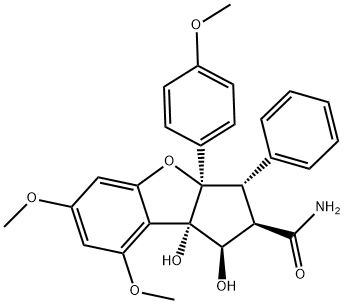177262-30-5
 177262-30-5 結(jié)構(gòu)式
177262-30-5 結(jié)構(gòu)式
基本信息
(1R,2R,3S,3aR,8bS)-1,8b-dihydroxy-6,8-dimethoxy-3a-(4-methoxyphenyl)-3-phenyl-2,3,3a,8b-tetrahydro-1H-cyclopenta[b]benzofuran-2-carboxamide
1H-Cyclopenta[b]benzofuran-2-carboxamide, 2,3,3a,8b-tetrahydro-1,8b-dihydroxy-6,8-dimethoxy-3a-(4-methoxyphenyl)-3-phenyl-, (1R,2R,3S,3aR,8bS)-
物理化學(xué)性質(zhì)
常見(jiàn)問(wèn)題列表
Eukaryotic initiation factor 4A (eIF4A)
Didesmethylrocaglamide (5 nM, and 10 nM; 72 hours; MPNST cells) treatment arrests MPNST cells at G2-M, increases the sub-G1 population, induces cleavage of caspases and PARP, and elevates the levels of the DNA-damage response marker γH2A.X, while decreasing the expression of AKT and ERK1/2.
Didesmethylrocaglamide inhibits MPNST cell proliferation by inducing cell cycle arrest at G2/M and subsequently, cell death. Didesmethylrocaglamide-treated 697-R cells exhibits IC
50
values is very similar to those of parental 697 cells (4 vs 3nM of IC
50
, respectively).
Didesmethylrocaglamide induces apoptosis in both neurofibromatosis type 1 (NF1)-expressing and NF1-deficient MPNST cells, possibly subsequent to the activation of the DNA damage response. Didesmethylrocaglamide-treated sarcoma cells show decreased levels of multiple oncogenic kinases, including insulin-like growth factor-1 receptor.
Western Blot Analysis
| Cell Line: | Malignant peripheral nerve sheath tumors (MPNST) cells |
| Concentration: | 5 nM, and 10 nM |
| Incubation Time: | 72 hours |
| Result: | Induced cleavage of caspases and PARP, and elevated the levels of the DNA-damage response marker γH2A.X. |